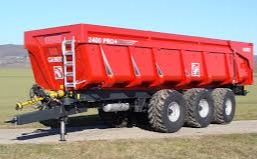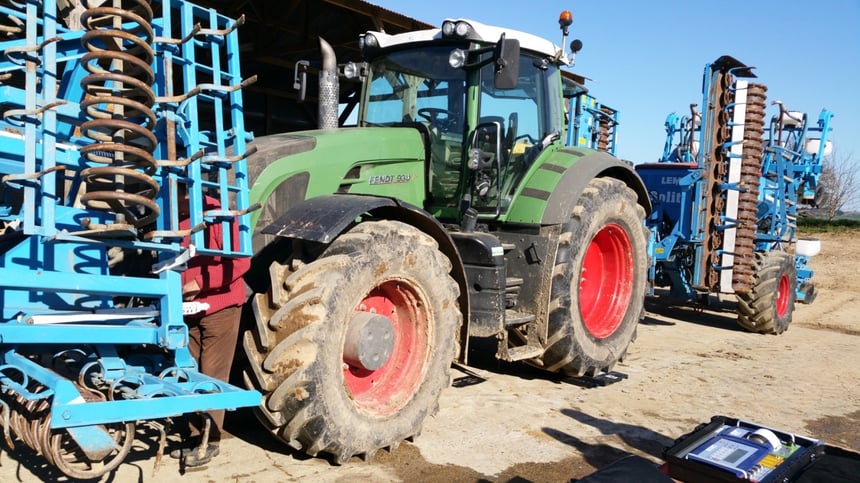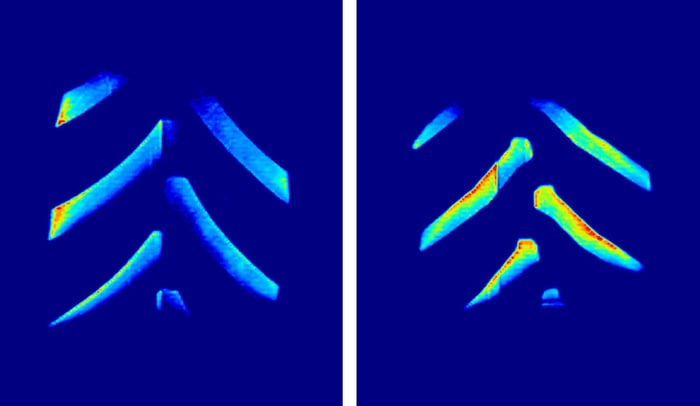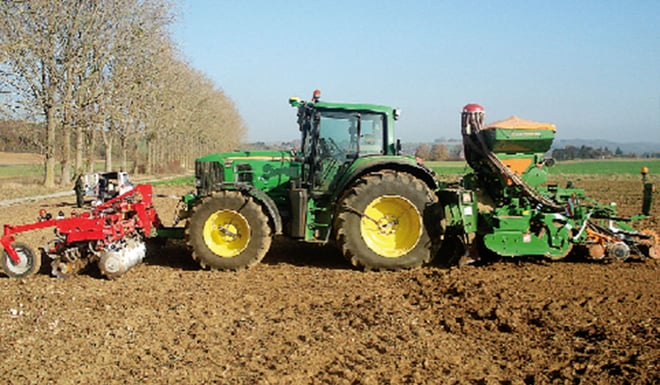To reduce your agricultural tyre budget and prevent your tyres from wearing too rapidly you need to adapt your choice of tyre and adjust your tyres optimally, making it essential to know the loads applied to each axle of your vehicle. It is the load that effectively determines the degree of pressure to your tyres and as such their wear...
Loads vary depending on the tools attached and what they are used for
The weight of agricultural vehicles is spread over one or more axles. In France, the axle load, which is to say the maximum load which can be borne by each axle, must be less than 13 tonnes.
The actual load borne by the vehicle will depend on the weight of the vehicle and/or the tool attached and its load as well as the number of axles and how they are spread out. The load therefore varies depending on the tools used as well as during the course of their use (loading/unloading cycle).

3 axle trailer
The weight distribution modifies the distribution of pressure on the tractor tyres
An important factor to take into account is therefore the weight distribution. It is a question of the additional load applied to an axle due to the attachment of tractor-drawn or semi-mounted tools.
In the case of trailer attachments coupled with a piton fix (for example ploughing tools, sedeers, trailers, skips, etc.), all or part of the tool mass is added to the tare measured back axle load. .
According to regulations, the weight distribution must always be lower than 3 tonnes. There can also be a transfer of weight to the front when there is a cantilever-mounted tool at the front of the tractor.
In all cases, the load on the front axle of a tractor must represent at least 20% of the total weight, in order to ensure good vehicle steerability and user safety.
Load measurement makes it possible to choose and adjust your tractor tyres
To optimise your tyres, the first thing to do is measure the load to each axle of your equipment (tractor, self-propelled machinery, trailers, etc.) as well as weight distribution after coupling to a trailer. This can be done using basic weighing equipment adapted to the volumes to be measured (see photo below).
 Weighing mechanism under the back axle
Weighing mechanism under the back axle
The information from the weighing will allow you to choose tyres with a load index adapted to your equipment and to adjust your tyre pressure to suit the work to be done.
If loads vary during use, an on-board inflation system could prove to be useful. In addition, knowledge of your tractor’s weight distribution will allow you to adjust the load if necessary by ballasting (weights on the vehicle or tyre ballasting with water).
Verification of the soil footprint makes it possible to validate tyre pressure adjustments
Verification of the footprint can complete the data obtained from weighing. This is done by pressure measurement (tyre pressure monitoring system available from certain tyre manufacturers).
The weight distribution must be as even as possible over the tyre tread in contact with the ground. Equal pressure is exerted on the lugs in the image on the left (below). The image on the right (below) shows uneven pressure with a high concentration of pressure at the level of the lugs. This should alert you that your tyre pressure needs adjusting.

Tyre pressure measurement
on the left, a load suited to the tyre, on the right an excess loadThe measurement and management of your pressure to the ground allows you to limit compaction thanks to a good distribution of weight and carefully adapted tyre pressure. This will help you optimise your work as well as the lifespan of your tyres and your equipment.
The Bridgestone-agriculture.eu blog is written and administered by tractor tyre experts who are available to provide you with the advice you need to maximise your productivity: agricultural tyre technical data, agricultural tyre performance, pressure advice for agricultural tyres, solutions for avoiding soil compaction, sprayer tyre pressure etc.
To take it one step further and increase the profitability of your farm, les Experts pneu provide a free, highly detailed white paper which explains the essential role of the agricultural tyre in your productivity..
Most people who read this article have also read some of the following articles:
This information is intended only to make you aware of the technical and functional aspects of agricultural tires and their use. It does not allow you to make a judgment or a definitive conclusion on a given problem. Only your agricultural tire expert is able to make a technical assessment and take a final decision, case by case.
Leave a
commentary
Your email address will not be published.
Required fields are indicated with *








